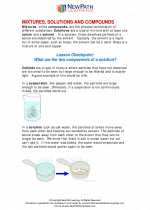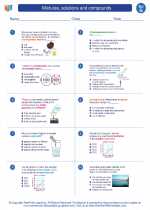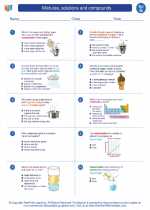Mixtures
A mixture is a combination of two or more substances that are not chemically combined. Each substance in the mixture retains its own chemical properties and can be physically separated from the other substances. Mixtures can be further classified into two types: homogeneous and heterogeneous mixtures.
Homogeneous Mixtures
Homogeneous mixtures have a uniform composition throughout, meaning the different components are evenly distributed and not easily distinguished. Examples of homogeneous mixtures include saltwater and air.
Heterogeneous Mixtures
Heterogeneous mixtures have non-uniform compositions, meaning the different components are not evenly distributed and can be distinguished easily. Examples of heterogeneous mixtures include a mixture of sand and water or a salad.
Solutions
A solution is a type of homogeneous mixture in which one substance is completely dissolved in another. The substance that is present in a smaller amount is called the solute, while the substance present in a larger amount is called the solvent. The solute particles are dispersed uniformly throughout the solvent. Solutions can be in various states, such as solid, liquid, or gas.
Examples of Solutions
- Saltwater - salt (solute) dissolved in water (solvent)
- Carbonated water - carbon dioxide gas (solute) dissolved in water (solvent)
- Brass - zinc (solute) dissolved in copper (solvent)
Compounds
A compound is a substance that is composed of two or more different elements chemically bonded together in a fixed ratio. Compounds have unique properties that are different from the elements that make them up. They can only be separated into their individual elements through chemical reactions.
Examples of Compounds
- Water (H2O) - composed of hydrogen and oxygen
- Carbon dioxide (CO2) - composed of carbon and oxygen
- Sodium chloride (NaCl) - composed of sodium and chlorine
Study Guide
When studying mixtures, solutions, and compounds, it's important to understand the following key points:
- The differences between homogeneous and heterogeneous mixtures.
- The distinction between solute and solvent in a solution.
- How compounds are formed and their unique properties compared to their constituent elements.
- Examples of mixtures, solutions, and compounds in everyday life.
Understanding these concepts will provide a solid foundation for further studies in chemistry and help in understanding the behavior and interactions of different substances.
.




